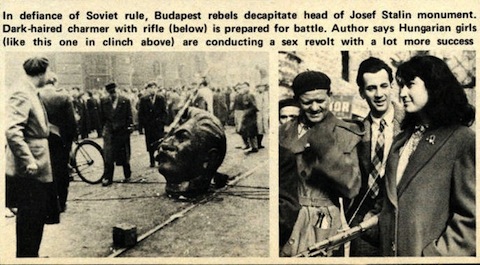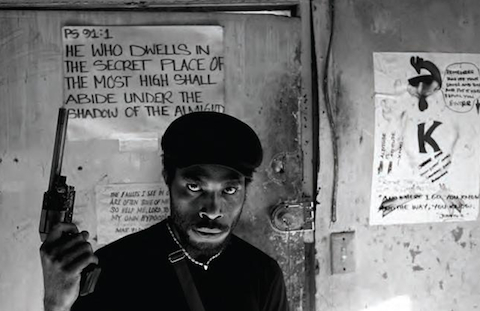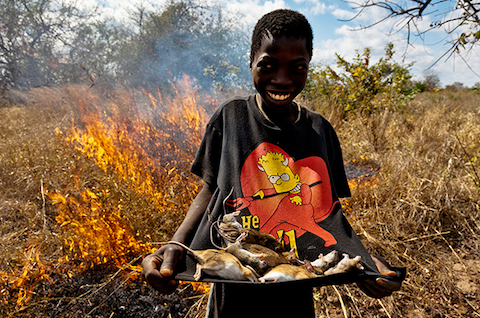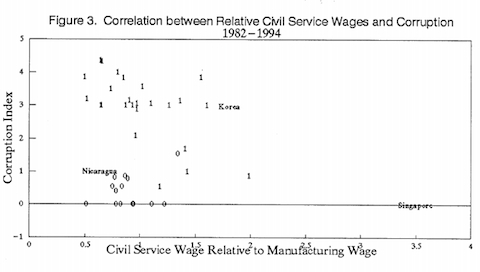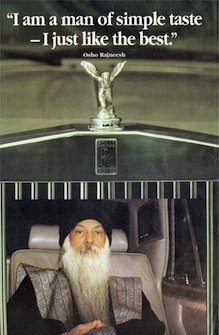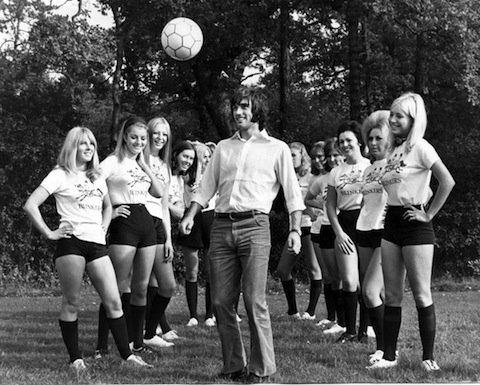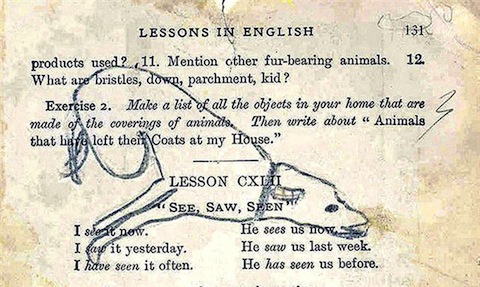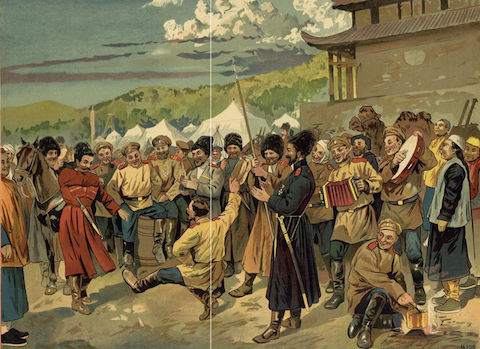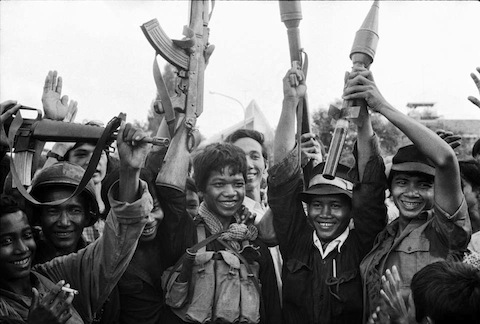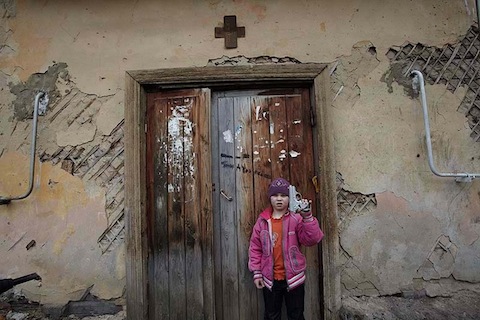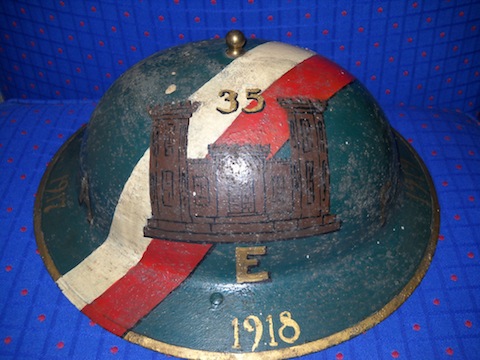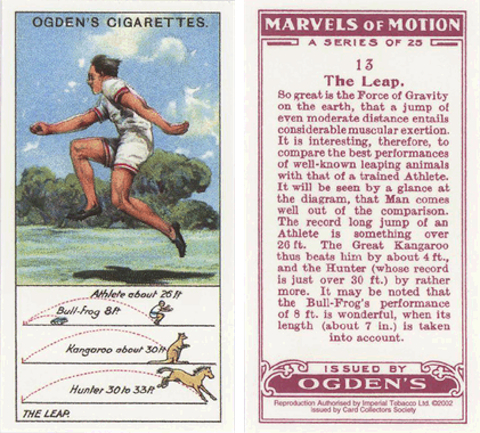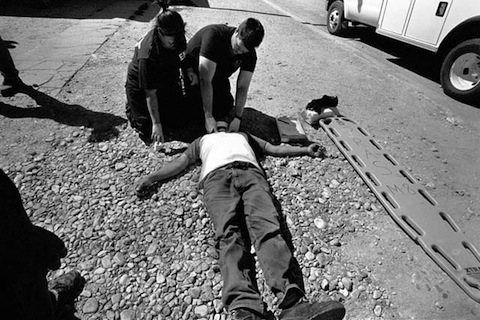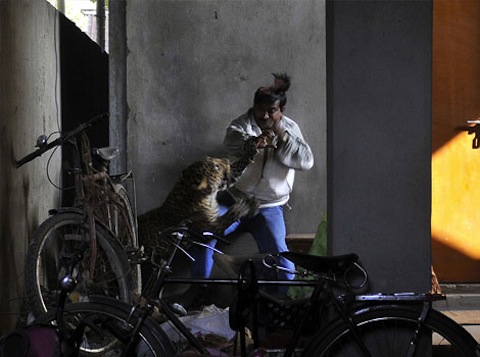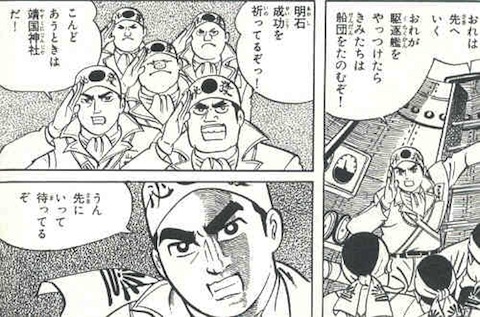April 23rd, 2012
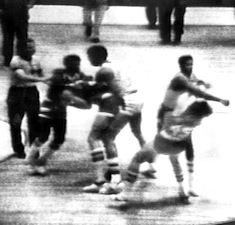 Watching Metta World Peace absolutely lose the plot in yesterday’s Lakers-Thunder contest made me think about the possible legal ramifications of on-court/on-field violence. Much has obviously been written about the possibility of treating such incidents as criminal matters, as has happened on occasion in the Canadian legal system. (The American system, by contrast, seems terribly reluctant to go down that path.) But perhaps the more interesting question is whether sports violence can lead to big-money civil actions. That’s precisely what happened after Houston Rockets guard Rudy Tomjanovich was infamously clocked in the face by Lakers power forward Kermit Washington; Tomjanovich sued the Lakers’ ownership group, arguing that the team had urged its players to act violently, and walked away with a multimillion-dollar settlement.
Watching Metta World Peace absolutely lose the plot in yesterday’s Lakers-Thunder contest made me think about the possible legal ramifications of on-court/on-field violence. Much has obviously been written about the possibility of treating such incidents as criminal matters, as has happened on occasion in the Canadian legal system. (The American system, by contrast, seems terribly reluctant to go down that path.) But perhaps the more interesting question is whether sports violence can lead to big-money civil actions. That’s precisely what happened after Houston Rockets guard Rudy Tomjanovich was infamously clocked in the face by Lakers power forward Kermit Washington; Tomjanovich sued the Lakers’ ownership group, arguing that the team had urged its players to act violently, and walked away with a multimillion-dollar settlement.
What is less known, however, is that Kermit Washington also contemplated filing a suit related to the incident—not against Tomjanovich or his employers, but against the NBA itself. Over twenty years after he threw the punch, Washington had his lawyer send a threatening letter to NBA commissioner David Stern. The text of that bizarre letter is included in John Feinstein’s The Punch:
Kermit feels that the NBA manipulated the situation when it occurred in 1977 for public relations purposes and worked against Kermit with NBA team owners to make Kermit the scapegoat and make the NBA look better to Kermit’s detriment. As a result, Kermit’s ability to flourish as an NBA all-star was undermined and any future opportunities with the league and in the basketball world in general were ruined…
Because of the false light that the NBA has cast Kermit in, every time an incident involving violence in sports comes up, Kermit’s involvement in the Tomjanovich incident and his subsequent suspension are repeatedly established by the NBA as a benchmark. It is our understanding that the NBA released footage of the incident and continues today to cast Kermit in a false light…
Kermit believes that he is entitled to compensation in the amount of five million dollars for the difficulty that he has faced for the last twenty-three years as a result of the actions of the NBA. Kermit has tried to maintain a good relationship with the NBA, but the poor treatment that he has received has pushed him to this point. Five million dollars is a small amount for the NBA to pay for the injustice that Kermit has dealt with for the last twenty-three years.
Once the NBA made clear its intention to vigorously defend itself should a lawsuit be filed, Washington failed to pursue his case. Which is actually too bad—it would have been interesting to see whether a jury could empathize with his plight.
Tags:basketball·Kermit Washington·law·Rudy Tomjanovich·sports
April 20th, 2012

I recently spent the better part of a day trying to verify a single, rather insignificant fact for my next book—namely, whether an interviewee’s claim to have received a certain model of Omega watch in early 1978 jibed with Omega’s production schedule. (It did.) Having expended way too much mental bandwidth to accomplish that one reportorial task, I can’t help but wonder how much better life would be if contemporary non-fiction operated according to the rules of Cold War-era pulp magazines. Because as this interview with the writer behind an article entitled “Budapest’s Sex Revolt” makes clear, accuracy was the least of that industry’s concerns:
You wrote hundreds of action, adventure and war stories for men’s adventure magazines. Did you also write a lot of “sex exposé” stories and were they your ideas or suggested by editors?
DORR: I wrote dozens of sex exposé stories and I did it all without having sex with anybody. With one exception involving one article, no editor ever suggested a topic to me. I simply looked at what the magazines were publishing and tried to copy it.
The Budapest story has references to true history and a lot of details about the city. How much was based on personal knowledge versus imagination?
DORR: I’ve never been to Budapest. I don’t remember how I wrote the story. I believe “pure imagination” was a big factor. Remember that any place with a faraway name was deemed exotic back in 1970 and not very many other Americans had ever been to Budapest, either.
Keep that in mind the next time some media pundit tries to convince you that the seventies were some sort of Golden Age of reportorial truth. Woodward and Bernstein were the exception, not the rule.
Tags:Hungary·reporting·sex·writing
April 19th, 2012

I highly recommend this set of Papua New Guinea images, by the Australian photographer Ben Bohane. The one posted above (larger version here) is a personal favorite for the way it juxtaposes the firearm with the quote from Psalms. I read that quote as so sinister in this context, but alternate translations give quite the opposite effect. Wish I could know whether the raskol who made that sign deliberately chose a translation that would fit with his crew’s nihilistic world view. Or if whatever Bible he stumbled across just happened to feature a version of the quote that was cosmically appropriate to his desperate circumstances.
More chilling photographs of raskols here and here.
Tags:Ben Bohane·crime·Papua New Guinea·photography·raskols·religion
April 17th, 2012
If all had gone according to plan, I would’ve handed in the complete first draft of my next book today. But, much to my discredit, I’m stil a whole chapter away from completion, plus a few more days’ worth of revisions. I can take some small comfort, at least, in knowing that I’m probably not the first writer to miss a major deadline. I mean, hey, we’re all still anxiously awaiting that runaway bride’s memoir, right?
Tags:movies·White Line Fever·writing
April 16th, 2012

Microkhan Jr. has reached the age at which he’s starting to ask about food taboos—like, why we eat pigs but not horses (a recent dinnertime inquiry). In straining to explain the nuances of societal dietary preferences, I thought of this incredible photo essay on the rat catchers of Mozambique, who provide that nation’s blue-collar workers with an affordable source of meat—albeit one that many Americans might find icky. Yet Mozambique’s appetite for this protein source is such that the rodent harvest is causing serious environmental damage:
Albinio Matias, a Mozambican farmer, lost his daughter, Cassula, and his home to wildfires, which also damaged his crops for four consecutive years. “The fires were set by youngsters hunting for rats, and because our houses were close to the weeds they caught fire and I lost everything,” said Matias, who lives in the Macossa district of Manica Province in central Mozambique. Hunters would start fires to flush out rodents from the forests and the bush to eat, and the blaze would often get out of hand.
Around 70 percent of Mozambique’s 20 million people live in rural areas where every year thousands are displaced or lose their possessions, homes and crops to these fires. Manica Province’s Forest and Wildlife Services said 43 wildfires were caused by rat hunters in 2007; in 2008 that figure rose to 60 and led to 15 deaths and the displacement of 200 families.
This is definitely an instance in which controlled production is far preferable to the “free-range” approach. But while our species has proven quite adept at wiping out rat populations, we’ve had a much harder time breeding them for meat—at least not profitably. Some reasons why can be found here; suffice to say that rats aren’t quite as compliant as, say, chickens when it comes to determining gender and organizing efficient breeding schedules.
Also, as detailed here, rats are actually quite sensitive to environmental toxins such as pesticides. That detail surprised me: You’d think any animal capable of thriving off congealed grease in the sewers of Washington D.C. would let a little aldicarb slide right off their backs.
The photographer behind the rat-catching series, Vlad Sokhin, is a gem, by the way; check out more of his work here.
Tags:agriculture·Mozambique·rats·rodents·Vlad Sokhin
April 12th, 2012

In countries where the rule of law is less-than-robust, traffic cops can often best be classified as entrepreneurs rather than law-enforcement officials. Their main concern is not keeping the streets safe, but rather extracting bribes from unfortunate drivers—a pursuit that has made some Zambian policeman rather wealthy by that nation’s standards:
Home Affairs Minister Kennedy Sakeni has wondered how a traffic officer can amass wealth worth K1 billion and yet his salary was only below K3 million. Mr. Sakeni says his office is aware that some of the officers make as much as K30 million per week which is never deposited into the government treasury but instead pocketed by themselves.
If my math is correct here, then, a Zambian traffic cop’s actual income is approximately 333 times greater than his official income. So how can the government coax those police into giving up such filthy lucre, save for prosecuting each and every one to the fullest extent of the law?
The convenient answer is that the cops’ salaries must be raised in order to reduce the temptation to extract bribes. But by how much? There is simply no way that the government can afford to replace all of the incomes that a cop would lose out on by going legit. How much of an increase will set a corrupt official on the straight-and-narrow?
There is quite a bit of debate on this point. This landmark IMF paper from 1997 (PDF) suggests that a public-sector official’s wages must be two to three times greater than that of his private-sector counterpart—a laughable proposition here in the U.S., of course, where civil-service salaries always lag. This case study from Tanzania (PDF), by contrast, concludes that even a massive salary bump doesn’t always do the trick:
For a [revenue office] employee who is used to get bribes of TSh 20–30,000 daily, a tenfold increase of his salary from the present level will not make him desist from demanding and accepting bribes. The situation worsened even more due to the erosion by inflation of the initial pay rates for TRA staff, since nominal wages between 1996 and 2000 remained unchanged.
The ultimate solution probably has less to do with wages than with developing a sense of common purpose. But that’s a slow fix that requires leadership by example. The lowliest official has no incentive to change his ways when the highest is taking suspiciously frequent ski vacations in Gstaad.
Tags:corruption·economics·Tanzania·Zambia
April 10th, 2012
As I re-apply nose to grindstone for the book’s sake, check out this footage from yesterday’s mass protest in Port Moresby. Despite its denials, the current Papuan regime is clearly intent on delaying this summer’s scheduled election, perhaps in the hope that Sir Michael Somare‘s influence or health will diminish. The Papuan people are rightfully getting tired of such electoral hijinks.
Tags:Occupy Waigani·Papua New Guinea·politics·Port Moresby
April 9th, 2012
 Anyone who takes the time to comment on Microkhan is pretty much on my cool list for all eternity. But I reserve extra-special love for those who help solve the mysteries this project occasionally explores. And so let me offer a cosmically enormous high five to the reader who recently responded to this January 2011 post about the Rolls-Royce fleet once owned by Bhagwan Shree Rajneesh. I mentioned that 84 of the cars were purchased by a Dallas auto dealer, who was backed by a doomed savings and loan. It wasn’t immediately clear to me whether the dealer ever managed to offload any of the cars, but apparently he found at least one taker for the notoriously gaudy vehicles:
Anyone who takes the time to comment on Microkhan is pretty much on my cool list for all eternity. But I reserve extra-special love for those who help solve the mysteries this project occasionally explores. And so let me offer a cosmically enormous high five to the reader who recently responded to this January 2011 post about the Rolls-Royce fleet once owned by Bhagwan Shree Rajneesh. I mentioned that 84 of the cars were purchased by a Dallas auto dealer, who was backed by a doomed savings and loan. It wasn’t immediately clear to me whether the dealer ever managed to offload any of the cars, but apparently he found at least one taker for the notoriously gaudy vehicles:
I know where one of the cars ended up: in my mother’s driveway. Yes, she purchased Rajneesh’s 1982 Silver Spur in possibly the ugliest baby blue one could imagine. It had what we know as the gold package, hood ornament and all – dipped in gold. I remember reading through the owner’s manual as a 15 year old and seeing the oringinal warrnanty card that read Rajneesh Investments. My mother was, as the time, president of the now defunct KIAB, Channel 23 in Dallas. This would have been her third Rolls Royce. She was as gay as a french horn and the cars fit her well (I was an adoptee).
I am still looking for confirmation on what happened to the “green-and-gold-lace number with tear-gas guns secreted beneath the fender.” Here’s to hoping this post teases out another tipster.
Tags:Bhagwan Shree Rajneesh·cars·cults·Rolls-Royce
April 6th, 2012
Taking Microkhan Jr. to the dinosaur museum today. I think he’s finally old enough to appreciate the true grandeur of a sauropod.
Tags:dinosaurs
April 5th, 2012
 Continuing on with our semi-regular practice of shouting out old Sports Illustrated stories that have stuck in our mind, I’d like to call your attention to this “Where Are They Now?” piece about the fabled Steve Dalkowski—a man who recently popped to mind when news of Ryan Leaf’s latest travails broke wide. The thumbnail sketch on Dalkowski is that he’s the greatest left-handed pitcher who never was—a wild fireballer who awed the great Ted Williams, yet was undone by alcoholism before he could truly make his mark in the game. As of last report, he resides in an extended-care facility, the victim of dementia caused by his longtime chemical dependence. A straight-up tragic tale any way you cut it.
Continuing on with our semi-regular practice of shouting out old Sports Illustrated stories that have stuck in our mind, I’d like to call your attention to this “Where Are They Now?” piece about the fabled Steve Dalkowski—a man who recently popped to mind when news of Ryan Leaf’s latest travails broke wide. The thumbnail sketch on Dalkowski is that he’s the greatest left-handed pitcher who never was—a wild fireballer who awed the great Ted Williams, yet was undone by alcoholism before he could truly make his mark in the game. As of last report, he resides in an extended-care facility, the victim of dementia caused by his longtime chemical dependence. A straight-up tragic tale any way you cut it.
What I remember most about the SI is one detail in particular—a classic example of a single observation that lays bare the essence of a character. The one about Dalkowski is the kicker to the paragraph:
At midseason in 1964, Baltimore released Dalkowski. He hung on for two seasons with the Pittsburgh Pirates’ and the Los Angeles Angels’ organizations. In Bakersfield in 1965 he married a schoolteacher named Linda Moore, but they divorced two years later. Soon he was in the California fields, picking cotton and sugar beets, beans and carrots. Dalkowski’s drink of choice was cheap wine, which he would buy when the bus stopped on the way to the crop field. Often he would place a bottle in the next row as motivation.
Makes me think that the rewards we all set up for ourselves really speak volumes about our core desires—desires that we may not wish to reveal to others, at least not overtly. When it comes right down to it, human psychology is astonishingly hamster-like.
Tags:baseball·psychology·sports·Steve Dalkwoski·wine
April 4th, 2012
As I steal another day to focus on the book—my deadline is less than two weeks away—I was hoping to ask y’all for a bit of help with a research matter.
Let’s say I walked into an American embassy or consulate in the spring of 1978, claiming to have lost my passport while traveling. What identification, exactly, would I have been asked to provide in order to obtain a replacement passport? You have no idea how hard it’s been to get a concrete answer to this question. And while I’m sure I could glean what I need from the State Department’s archives, I’d rather not invest the time/money in a Bolt Bus trip down to Washington D.C. Fingers crossed that someone in the Microkhan audience can provide a little insight, or at least point me in the direction of a resource I can tap from the comfort of my global headquarters. Thank you in advance for the helping hand.
Tags:bureaucracy·snake handling
April 3rd, 2012

For those of us who lack law degrees, reading judicial opinions can often be a major slog. Those who occupy the bench favor a prose style that is, to be charitable, a bit on the dry side; yarn-spinning is not their forte. Yet every once in a while, I stumble upon a ruling that crackles like the fine narrative non-fiction. This 1992 circuit-court opinion in the matter of U.S. v Lowry is an excellent case in point.
Instead of summarizing the background, how ’bout we let Judge John Louis Coffey set the scene:
In the early 1960s Donald Lowry published a book about his travels through Mexico entitled Mexico: Bachelor’s Paradise. The response to the book convinced Lowry that there were many men out there who lacked self-confidence and had trouble with relationships, and that he could help these men by establishing a mail-order lonely hearts club. He followed through on this idea and founded such a club in 1965. After running this club for a few years, Lowry incorporated his business under the name of Col International, “Col” being an acronym for “Church of Love” (hereinafter “COL”).
It is the premise of the COL that lends spice to the script. Using mailing lists acquired from men’s magazines and various lonely hearts clubs, Lowry mailed informational packets to thousands of men describing the COL and its purpose. These letters claimed that the COL was founded in Mexico in 1965 by a teenage girl, Maria Simona Mireles, who now went by the name “Mother Maria”. According to the letters Mother Maria had been called to establish a new Garden of Eden, a valley paradise to be known as “Chonda-Za”. In Chonda-Za, COL members would join with Mother Maria and an entourage of beautiful young women known as the “Angels of Love”, living the rest of their lives in utter peace and fulfillment. Neither Rome nor the Garden of Eden was built in a day, however, and at present Chonda-Za was still a shimmering dream, though progress was being made. In the meantime, the mailings revealed, Mother Maria and the Angels were living on an old farm near the western Illinois town of Hillsdale, frolicking in a bucolic encampment known as the “Retreat”. At the Retreat the Angels were purifying themselves for entry into Chonda-Za and perfecting a free and open pastoral lifestyle, uninhibited by the moral code and strictures that modern society places on male-female relationships. This would be the lifestyle enjoyed by all in Chonda-Za.
From this idea sprang perhaps the most lucrative lonely-hearts scam in American history, one that eventually raked in an estimated $31.5 million. Lowry and his chief accomplice, Pamela St. Charles, did this not only by collecting membership fees from men who wished to retire to Chonda-Za, but also by coaxing their marks into contributing to special funds for the upkeep of the fictional paradise. Coffey explained the mechanics: [Read more →]
Tags:Chonda-Za·Church of Love·crime·Donald Lowry·law·Mexico
April 2nd, 2012
Crashing on a major Wired deadline today. In my absence, please enjoy the North Korean propaganda video above, featuring the least enthusiastic narrator in the history of film. Back tomorrow with something truly splendid from the history of swindling.
Tags:North Korea·satellites
March 30th, 2012

I got in a spirited discussion yesterday regarding New York’s abundance of one-dollar dumpling shops. In my dozen-plus years of calling this metropolis home, the special these joints offer has never changed, even though their various costs (especially rent) have certainly increased a fair bit. And though I realize that many of them probably skirt labor rules, I can’t imagine they have shaved enough off wages to compensate for other expenses.
In looking to explain why that one-dollar price has remained static, then, I began researching the various technologies that have kept pork prices so absurdly low. To my surprise, the real cost of pork has tumbled over the past four decades; a pound of pork that would’ve wholesaled for $3.95 in today’s dollars in 1970 now goes for $1.52. I have to think one of the main reasons for the plunge is greater efficiency on farms, a product of gadgets like the Nedap Velos heat detector. As the machine’s sales literature so eloquently phrases its benefits:
The more accurately it can be determined whether a sow is on heat, the more efficient the operational management…Nedap Velos alerts you on time to when a sow requires insemination. Without you having to monitor this yourself. Based on this information, you can organise the different tasks.
While I have no intention of giving up my affinity for pork-and-chive dumplings, I will confess that there’s something a bit creepy about the cold mechanization of porcine reproduction. Napoleon would not approve.
Tags:agriculture·Animal Farm·pigs·technology
March 28th, 2012

For those of y’all who follow my microblog, you might have noticed a recent fascination with pop-culture relics of the early Atomic Age. That interest is a spin-off of a book-related strand about America’s early nuclear reactors, one of which plays a small-yet-pivotal role in the plot. As I iron out some kinks in that particular scene today, please check out Dagwood Splits the Atom, which I found to be a surprisingly cogent refresher course on nuclear physics. I’m embarrassed to admit how poorly I scored on the wrap-up test at the end.
(Image via The Ephemerist)
Tags:books·comics·Dagwood Splits the Atom·nuclear power
March 27th, 2012

So I have something pretty un-American to confess: this year, for the first time since my days in Dublin, I’ve been following Premier League soccer like mad. Things have gotten to the point, in fact, that I’m seriously considering a late-afternoon work break in order to watch the Sunderland-Everton FA Cup quarterfinal. I can’t only blame Among the Thugs for this newfound obsession; slogging through the book has honed my interest in the limits of human performance, and there are few better laboratories for studying such a topic than the high-stakes realm of English soccer.
A big part of what I find fascinating about the sport is not necessarily the physical exertions involved, but the way that athletes are able to excel in spite of their many demons. Perhaps the classic example of a man who dealt with that inner tug-of-war is George Best, whose tragic career arc is well-chronicled in this humdinger of a photo gallery. Flipping through those hundreds of images spurred me to track down this brutally candid two-part interview with Best, in which one installment was done in 1984, the other in 1990. Best’s demeanor really shifts from one part to the next, obviously in reaction to some tough times in retirement. I was just floored by his account of the wretchedness of a former star’s post-career life in England:
JW: You’re a fighter yourself?
George Best: I have no choice. I walk around the streets of London and, wherever I go, someone wants to pick a fight with me. I’m talking about kids, eighteen-year-olds. There’s always some arsehole who wants to be the boss. They want to be Jack The Lads, tell their mates they gave a punch to George Best. I don’t mind because I can take care of myself, even at my age. I don’t lose many fights either. This is my local. I come here for a drink, a bit of peace and quiet. I’ll happily sit here for hours doing the crossword, minding my own business. Every day someone has a go at me.
JW: Don’t you ever walk away from these situations?
GB: I should walk away but I don’t. Because I can’t stand the idea that someone thinks they’re better than me. Not being able to walk away from aggravation, that’s my biggest problem. If anyone wants to give me hassle I’ll stand up and give as good I get, then some more. I might get the sh*t kicked out of me but, at the same time, I’ll never back down to anyone. I used to back down but not any more. If anyone gives me trouble I will beat the fucking shit out of them.
Just last week, these three guys followed me out of the pub and started in on me up the road. They were kicking lumps out of me. I sent two to hospital and they’ll remain there for a long, long time. The other one wouldn’t go down. But neither would I. In those situations I go nuts. They get to see the Belfast kiss. It’s not a pretty sight. I’m Irish. I like fighting. If they want to fuck me, I’ll fuck them. The other night fifteen of them came in here looking for trouble. England fans. They started smashing milk bottles and pint glasses over my head. They narrowly missed my eyes. Why should I put up with people smashing bottles over my head? Or trying to stick broken bottles in my eyes? Look at my face, Jon. Closer. I’ve got 268 stitches in there.
JW: It sounds like being George Best is a large burden to carry.
GB: That’s a good way of putting it, actually. It’s a fucking huge burden.
Perhaps I’m mistaken, but I can’t remember ever hearing such tales from a retired American athlete. Does Michael Jordan have to deal with folks challenging him to fights all day?
(Image via mcshanebest)
Tags:Among the Thugs·England·George Best·soccer·sports
March 26th, 2012
Starting off the week by immersing myself in Chapter Sixteen of the book. Twenty-six days ’til my deadline and I’ve got another ten thousand or so words to go. It ain’t gonna be pretty, but I think I’ve got a shot at pulling this one out. While I focus on today’s chunk of the narrative, listen to the fine selection above, culled from the latest Fresh Produce podcast. Back tomorrow with something on either maritime disasters or the high price of fame.
Tags:disco·Fresh Produce·Jaymz Bedford·music
March 23rd, 2012

A big part of my book research has consisted of purchasing obscure, tattered tomes that have obviously passed through dozens of hands before reaching my global headquarters. One of the delights of obtaining such artifacts is the marginalia they sometimes offer—I just recently discovered, for example, a scribbled note in a discarded library book that read, “Nelly why not?” There is no Nelly mentioned in the printed text, so I can only assume that this mysterious Nelly had a hold on a reader’s heart. (Or maybe he just couldn’t get tickets to a Nelly show back in the early ’00s.)
The Knoxville-based artist Jean Hess obviously shares my interest in these stray shards of daydreams, as evidenced by her awesome collection of what she terms “childhood graffiti.” Here she is trying to explanation the fascination:
Much of what these children left behind spoke of familiar concerns – love and sadness; friendships and crushes; people, flowers, animals and mysterious creatures; homes and even the occasional car, truck or airplane. They have left messages, I think — poignant signifiers of a rather naïve or innocent past that is lost to us. So I am gathering the stuff of nostalgia, longing, and the idea of Eden. And, too, I like to think that this is an act of preservation and hence of respect for people who are now gone.
These doodles resonate because they were created in moments totally devoid of self-consciousness. The artists never intended for another living soul to see their work—these drawings were for them, and them alone. I so often find myself wishing I could achieve that uninhibited state of mind while writing. I’m actually not sure I ever have—or at least not since I scribbled “HOISOI RULES” on my 8th-grade algebra notebook.
Tags:art·books·graffiti·Jean Hess
March 21st, 2012
Granted, you have to give (very minor) props to Turkmenistan’s president for his guitar chops (see above). But don’t be fooled into thinking he’s helming a nation any less repressive than the one he inherited from his infamous predecessor. The Turkmen government has zero patience for those who might dare question its absolute authority to do whatever the hell it pleases:
“The people regularly broadcast reports on events that take place in Turkmenistan, about human rights, for example, and they share their opinions. It’s fine for them to do so,” Turkmen Deputy Foreign Minster Vepa Hadjiyev told the committee. “However, when it comes to journalism, that is somewhat different. People are allowed to collect information and disseminate it. Radio Azatlyk has the right to do so.”
This must come as news to RFE/RL correspondent Dovletmyrat Yazkuliyev, who was arrested and sentenced to five years in prison in October 2011 on false charges that he had aided in the attempted suicide of a family member. The government’s scurrilous allegations were widely believed to be connected to Yazkuliyev’s reporting about an arms depot explosion that killed dozens in the Turkmen city of Abadan. He was later pardoned and released only after complaints from international advocacy organizations and intense diplomatic pressure from the United States led the Turkmen government to reconsider its position.
Yazkuliyev made out relatively lightly compared with Azatlyk contributor Sazak Durdymuradov, who in June 2009 was arrested and confined to a psychiatric institution known as the “Turkmen Gulag,” where he was beaten and psychologically abused by Turkmen authorities.
And if she could still raise her own objections, Ogulsapar Muradova — an RFE/RL correspondent who died in 2006 while in government detention on trumped-up charges — might have a thing or two to say about Hadjiyev’s response to UN inquiries.
Here’s a slightly more thorough list of Turkmen journalists who’ve faced abuse (or worse) for simply doing their jobs. Alas, I see no reason why the situation should start to get better before it gets worse.
Tags:censorship·journalism·music·Turkmenistan
March 20th, 2012
You’re gonna be hearing a lot more than usual ’bout Azerbaijan in the coming days, since the nation will be playing host to that wretched entertainment ritual known as Eurovision 2012. The event is supposed to be a coming-out party of sorts for the so-called Land of Fire, which would very much like to attract more Western investment. But those who might contemplate plunging their cash into Azerbaijan should be aware that the Soviet ways die hard in the country. Just ask Khadija Ismayilova, a journalist who is facing a most odious sort of persecution for investigating government corruption:
On March 7, Ismayilova received a letter with the words “behave, whore, or you will be shamed,” along with an envelope of photos taken inside her house of her engaged in sexual activity. The same letter was also sent to two opposition-leaning newspapers, which did not publish the pictures.
On March 14, after Ismayilova stated said in public that she would ignore the threats, video footage – again clearly filmed with a spy camera – inside her home, was posted on a website ostensibly linked to Musavat, an opposition party which has a newspaper of the same name. Both denied any connection to the website, but many internet users were clearly misled into believing they were responsible for carrying the video, judging by the angry comments they posted.
Ismayilova believes the underhand campaign against her is a consequence of her investigations into high-level corruption in Azerbaijan. Her recent report into the business activities of President Ilham Aliyev’s daughters, published by RFE/RL, was one of the very rare Azeri-language articles to discuss the first family.
Ismayilova quickly entered my pantheon of heroes for refusing to be cowed by the stealth footage of her bedroom activities—footage that was obviously taken by President Aliyev’s security apparatus. The whole scheme actually has a Keystone Kops element to it, for the blackmailing backfired in spectacular fashion—Ismayilova is now so high-profile that she cannot be disappeared without causing massive backlash against Aliyev’s regime. I hope Ismayilova will take advantage of that fact and now press forward with her reporting with renewed vigor.
I am curious to know what the dictator’s wife thinks of all this. Perhaps she should have been asked in this laughably softball interview, in which she was allowed to parry accusations that the government was demolishing homes to make way for Eurovision-related structures. Gotta love the obsequiousness of the interviewer: “I have to ask the following question…” As if it pains him to do his job.
Tags:Azerbaijan·dictatorship·Eurovision·Ilham Aliyev·journalism·Khadija Ismayilova
March 19th, 2012
Parent-teacher conference plus a gainfully employed Grand Empress equal Microkhan on full-time parenting duty today. Which is probably for the best, because a full weekend of writing has left my brain feeling like a desiccated sponge. Hoping to recharge by taking Microkhan Jr. for a trip on the Roosevelt Island tram.
Tags:Billy Preston·music
March 16th, 2012
It has been far too long since I have cast Microkhan’s spotlight on Papua New Guinea, one of this project’s most beloved topics of conversation. The troubled country has an election due this summer, one that could well be delayed by a government desperate to cling to power. In the meantime, that government is wrestling with a scandal involving Deputy Prime Minister Belden Namah, who was allegedly a very naughty bloke at an Australian casino:
The Deputy Prime Minister of PNG Belden Namah has been accused of sexually harassing a male blackjack dealer at the casino and behaving in a drunk and threatening manner.
According to the reports Mr Namah was allegedly gambling in the high roller room at around 7am on April 16 last year when he was asked to stop drinking due to “intoxication.”
A blackjack dealer then alleges Mr Namah started “teasing me by asking my mobile number” and then allegedly said to the man “Can I f… you tonight?”
This was followed up with “Can I love you, u (sic) are so pretty to me” and repeated requests for sex and to meet the man outside according to the dealer’s statement.
The staff statements from five separate employees say that despite the alleged sexual harassment the casino allowed Mr Namah back into the venue several hours later when it allegedly learnt he had paid $800,000 into a gambling account for use at the casino.
Namah’s response to the casino’s accusations has been, to be charitable, completely tone deaf. His lawyer has adopted the R. Kelly tactic of claiming that the man in the incident report simply isn’t Namah. Meanwhile, Namah himself has threatened to sue the Australian media group that published the casino’s allegations—though his reason for being upset is rather telling about the state of Papuan politics:
Mr Namah demanded the Fairfax group – publishers of the story – retract the “misleading and unfounded claims.”
“I want to make it clear, I am not gay,” the Port Moresby based National newspaper quoted him as saying.
Ah, so that is what Namah is worried about—the insinuation that he might be gay. Not a peep about being offended by claims that he was gambling away AUS$800,000, an outrageous sum for a longtime government official from a desperately poor country. The fact that Namah doesn’t understand that this is the real scandal, rather than the questions over his sexuality, does not bode well for Papua New Guinea.
Tags:Belden Namah·corruption·gambling·Papua New Guinea·politics
March 15th, 2012

Unlike the fine fellows in the tsarist poster above, the title of which translates as “A Time for Relaxation,” I ain’t got time to kick back and Microkhan today. Still stuck on the second paragraph of my book’s fifteenth chapter, and I need to push through that block. Acquaint yourself with some fantastic Siberian artifacts, and I’ll loop back to y’all once I have a good 2,000 words or so.
Tags:art·Russia·Siberia
March 14th, 2012

This spot-on passage from Mark Bowden’s Guests of the Ayatollah is something that I’ll be keeping at the forefront of my thoughts today, as I tackle an especially tricky section of my book:
Revolution gives ordinary people the false belief that they can remake not just themselves, their country, and the whole wide world but human nature itself. That such grand designs always fail, that human nature is immutable, that everyone’s idea of perfection is different—these truths are all for a time forgotten. Those in the grip of righteousness saw an opportunity—no, the need—to weed the impure from their new and glorious garden.
The photo above comes from Roland Neveu’s series about the 1975 fall of Phnom Penh. How you wish the smiling soldiers in those images could have heeded Bowden’s words.
Tags:books·Cambodia·Guests of the Ayatollah·Iran·Mark Bowden·photography
March 13th, 2012

When I first traveled in the post-Soviet world many moons ago, one thing that struck me was how all the restaurant menus listed foods by specific amounts. In Michal Kováč-era Bratislava, one did not order a small or large platter of dumplings; you either got the 200-gram size or the 500-gram size. And I have no doubt that those weights were precisely measured on a kitchen scale—a practice that was a vestige of the days of Communist rigidity.
Given how that culinary experience stuck in my mind, I was naturally drawn to this photo essay that visualizes the suggested daily food intake in Yekaterinburg, Russia. It’s a salient reminder that our bodies are ultimately just machines, a fact that governments use to their advantage when resources are scarce.
Impressed by the essay, I just had to go and unearth the photographer’s other work. And I’m glad I did, because Fedor Telkov boasts an impressive portfolio of images from the less salubrious corners of his native Russia. Check out his collections from Eastern Mari prayer meetings, the backwoods of the Sverdlovsk Region, and the fishing holes of the Central Urals. The captions are all in Russian, but that’s why someone much smarter than I invented automatic web-page translation.
Tags:Communism·Fedor Telkov·photography·Russia·urban decay
March 9th, 2012

One of the very first Microkhan posts was about so-called trench art, a catch-all term for the artifacts that (usually ill-fated) soldiers created during their World War I downtime. It’s a genre I love dearly because it basically amounts to a big middle finger to madness—a way for the cannon fodder to achieve some small measure of victory over the heartless machine hurtling them to their deaths. Also, the geek in me can’t help but admire the technical skill that went into creating such intricate baubles.
I was overjoyed, then, to stumble across a whole new field of trench art: handpainted helmets, many of which betray their wearers as deft with the brush. Wish I could find a larger compendium of examples, but The Tubes are yielding little this morning. I have to figure that upon returning safe-and-sound from the Western Front, many veterans tossed their beautifully painted gear; I can certainly understand how one might not wish to be constantly reminded of such a shattering experience.
Rare American examples of the craft here and here, though I suspect that the latter helmet was at least partially restored after the guns fells silent.
Tags:art·helmets·trench art·World War I
March 8th, 2012

Stealing a day to seal myself up in the writing cave, with the goal of getting halfway through Chapter Fourteen. Occupy your spare moments by sifting through this impressively complete collection of vintage track-and-field trading cards. The comic-book covers are also worth your time; I had no idea about Scrooge McDuck’s pole-vaulting prowess.
Tags:comics·Scrooge McDuck·sports·track and field
March 7th, 2012

I’ve written before about how a single observation can elevate a work of non-fiction into the realm of true art. That is certainly the case with this New York Times dispatch from Whiteclay, Nebraska, a town infamous for providing alcohol to the neighboring Pine Ridge Indian Reservation. It’s a solid piece of reporting, for sure, but the various quotes and historical backgrounders all pale in comparison to this description of a Whiteclay garbage heap:
Dozens of people in various states of inebriation wandered along the road. Other men and women were passed out in front of abandoned buildings. A Hank Williams Jr. 45, “I’d Rather Be Gone,” was among the detritus along the road, as well as empty liquor bottles, a copy of “Tabernacle Hymns No. 3,” soiled clothing and a dead puppy.
“…and a dead puppy.” Let that image marinate in your mind for a moment. You needn’t read another word of the story to feel the depths of Whiteclay’s bleakness in your gut.
(Image via Lyric R. Cabral; highly recommend her “Manifest Destiny” series about Whiteclay)
Tags:alcohol·Native Americans·Nebraska·Whiteclay·writing
March 6th, 2012

The recent kidnapping of two Assamese forestry officials may have been peacefully resolved, but the caper hints at a deepening problem in India’s long troubled North-East. No, not the continued prevalence of insurgent groups that double as organized-crime outfits, but rather the bulldozing of woodlands that are the region’s foremost natural resource. The forestry officials were rumored to be targeted because the Karbi Peoples Liberation Tigers (KPLT) didn’t like the cut they were getting from government-negotiated timber deals.
One of the principal side effects of this increasing deforestation is something truly nasty: a huge upswing in leopard attacks on humans, even in densely populated urban areas:
Assam has seen a spurt in man-animal conflicts, particularly human attacks on leopards, over the past few weeks. Last week, villagers not only killed two leopards — one in Dibrugarh district and the other in Kamrup — but also shared their meat at both places. In the Kamrup incident, at least eight persons had been injured when two leopards attacked them in a field, following which the villagers killed one of them; the other escaped.
In Guwahati, at least five leopards have been rescued in the past two months while four have been killed. A man had also died in the heart of the city after being attacked by a leopard in January. The latest incident was on Sunday, when a full-grown leopard was injured after it fell into a well in the Boragaon, Guwahati…
“Leopards are indeed under severe threat across the state. Increasing conflict between people and wild animals, more particularly leopards, has become a major problem, especially with a section of the people violently retaliating, causing injury and even death to the animals,” said S P Singh, state chief conservator of forests (wildlife). Forest Minister Rockybul Hussain said a committee has been constituted to examine how this could be checked.
Knowing a bit about how things operate in India’s North-East, I can’t imagine the government doing anything meaningful to help out. Officials in the region have a terrible track record when it comes to addressing the needs of ordinary citizens. They will likely be content to let vigilantism handle the problem, to the great detriment of the leopard’s future.
Tags:animal attacks·Assam·corruption·environment·India·kidnapping·leopards·North-East India
March 2nd, 2012

I’m a point in my book where I need to describe a cultural misunderstanding, one that has dire consequences for all parties involved. It’s a tricky thing to describe, since my worldview naturally aligns with the American characters—in trying to write the scene, I keep on expressing too much sympathy for their predicament. To wriggle out of that closed perspective, then, I’ve been thinking about one of my all-time favorite examples of cultural explication: Yoshio Emoto’s attempt to tell a Western audience why his fellow Japanese were so reluctant to surrender during World War II. Few other anecdotes about human conflict have made such a deep impression on me:
Westerners often ask me how the Japanese could choose death over surrender. I have to bring up the traditional notion of sacrifice and heroism in the defense of the nation, “Yamato Damasii.” It comes largely from the spirit of the Samurai. We were taught that “Yamato Damasii” was a virtue, a fundamental principle of the Japanese people. To be taken captive was against this principle, and the biggest shame and disgrace to us. On one mission, one of the men in my unit was shot and critically wounded. He was young and had a wife and small children. I asked him whether he wanted to leave a message for anyone. He said there was no message to leave. Then he faced the direction of the Imperial Palace, threw his hands in the air and said, “Long live the Emperor!” and died. I do not think that Westerners can fully understand this behavior.
I might quibble with his last line, though. I don’t think true understanding of differing worldviews is beyond our species’ capacity. I just think it takes a heckuva lot of work—more than most people are willing to put in.
(Image via the truly awesome Kamikaze Images)
Tags:Japan·kamikaze·philosophy·The Next Book·World War II
 Watching Metta World Peace absolutely lose the plot in yesterday’s Lakers-Thunder contest made me think about the possible legal ramifications of on-court/on-field violence. Much has obviously been written about the possibility of treating such incidents as criminal matters, as has happened on occasion in the Canadian legal system. (The American system, by contrast, seems terribly reluctant to go down that path.) But perhaps the more interesting question is whether sports violence can lead to big-money civil actions. That’s precisely what happened after Houston Rockets guard Rudy Tomjanovich was infamously clocked in the face by Lakers power forward Kermit Washington; Tomjanovich sued the Lakers’ ownership group, arguing that the team had urged its players to act violently, and walked away with a multimillion-dollar settlement.
Watching Metta World Peace absolutely lose the plot in yesterday’s Lakers-Thunder contest made me think about the possible legal ramifications of on-court/on-field violence. Much has obviously been written about the possibility of treating such incidents as criminal matters, as has happened on occasion in the Canadian legal system. (The American system, by contrast, seems terribly reluctant to go down that path.) But perhaps the more interesting question is whether sports violence can lead to big-money civil actions. That’s precisely what happened after Houston Rockets guard Rudy Tomjanovich was infamously clocked in the face by Lakers power forward Kermit Washington; Tomjanovich sued the Lakers’ ownership group, arguing that the team had urged its players to act violently, and walked away with a multimillion-dollar settlement.

